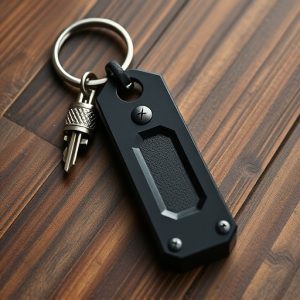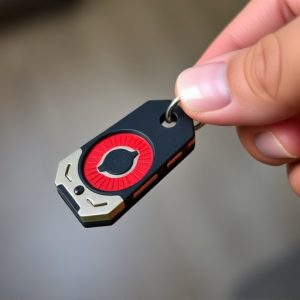Heart Attack Keychain: Legal Carry Guidelines by State
The Heart Attack Self Defense Keychain is a compact, legal self-defense tool, but its carriage is go…….
The Heart Attack Self Defense Keychain is a compact, legal self-defense tool, but its carriage is governed by varying state laws in the US. Understanding these regulations, from stringent to permissive, is vital for responsible citizens aiming to protect themselves. These keychains, with alarms and blades, offer peace of mind and tangible evidence in emergencies, as demonstrated by real-life case studies. Staying informed about local stun device laws ensures compliance and strengthens one's right to self-defense.
In today’s uncertain world, individuals are increasingly seeking effective self-defense tools for personal safety. One such device gaining traction is the Heart Attack Self-Defense Keychain, a compact and discrete option. This article explores the legal considerations surrounding defensive keychains in various US states. We delve into the nuances of self-defense laws, dissecting specific guidelines that dictate their carry. Understanding these regulations is crucial for individuals aiming to legally protect themselves with this innovative tool, particularly in states with unique provisions.
- Understanding the Legal Framework for Self-Defense Tools
- The Heart Attack Self-Defense Keychain: A Brief Overview
- States with Specific Guidelines for Defensive Keychains
- Carrying a Keychain for Self-Protection: What You Need to Know
- Case Studies: When and How the Heart Attack Keychain Has Been Used Legally
Understanding the Legal Framework for Self-Defense Tools
In many jurisdictions, the legal carry guidelines for self-defense tools like the Heart Attack Self Defense Keychain are governed by a nuanced understanding of individual rights and public safety. It’s crucial to navigate this framework, which often strikes a delicate balance between personal protection and regulatory oversight. Laws vary widely across states or regions, dictating who can possess certain devices, where they can be carried, and under what circumstances they can be deployed.
Understanding these legalities is essential for responsible citizens looking to arm themselves with self-defense tools. The Heart Attack Self Defense Keychain, designed to incapacitate an assailant through a powerful stun or even potentially causing a heart attack, operates within a specific legal paradigm. Awareness of local and state regulations regarding stun devices, personal alarms, and similar tools is paramount. Staying informed about case law and legislative changes ensures compliance and enhances the legitimacy of one’s right to self-defense.
The Heart Attack Self-Defense Keychain: A Brief Overview
The Heart Attack Self-Defense Keychain is a revolutionary tool designed to empower individuals with a simple yet effective means of self-protection in case of an unexpected cardiac emergency. This compact device attaches to a keychain, making it easily accessible and discreet. When activated, it emits a powerful alarm that can attract attention and deter potential attackers, providing crucial time for help to arrive. The keychain is especially beneficial in high-risk areas or for individuals who may be alone during their daily commutes.
Its compact size and lightweight design ensure it can fit comfortably on a keychain without adding significant bulk. This allows users to carry it effortlessly while going about their day, offering peace of mind knowing they have a personal safety net within reach. The Heart Attack Self-Defense Keychain is a game-changer for those seeking an affordable and reliable self-defense solution that doesn’t compromise on effectiveness or portability.
States with Specific Guidelines for Defensive Keychains
Many states in the US have specific guidelines regarding the legal carry of defensive keychains, also known as heart attack self-defense keychains. These laws vary widely across the country, reflecting differing perspectives on personal protection and public safety. Some states, like New York, have strict regulations that limit the types of devices considered legal for self-defense. In contrast, other states, such as Texas, offer broader protections, allowing the carry of certain defensive tools without a permit.
States with specific guidelines often require users to meet certain criteria before legally carrying a heart attack self-defense keychain. This might include attending certified training courses and obtaining permits or registration for the device. The variability in these guidelines underscores the importance for individuals looking to arm themselves for protection to thoroughly research local laws, ensuring they remain compliant with their state’s specific regulations.
Carrying a Keychain for Self-Protection: What You Need to Know
Carrying a keychain for self-protection, especially one designed for heart attack self defense, is more than just a trendy accessory—it could be a life-saving tool. These compact devices are typically equipped with features like emergency alarm buttons and sharp blades, offering peace of mind in potentially dangerous situations. The small size makes them easy to carry on your keyring or even tucked away in a pocket, ensuring you’re prepared should you encounter an attacker.
Understanding the legal aspects of carrying such a keychain is crucial. Different states have distinct guidelines regarding self-defense weapons, so it’s essential to familiarize yourself with the local laws. Some areas may permit these defensive keychains for personal protection outside the home, while others might restrict their use to specific locations like your property. Staying informed about these regulations will help you legally and responsibly utilize a heart attack self defense keychain as a means of safeguarding yourself.
Case Studies: When and How the Heart Attack Keychain Has Been Used Legally
In recent years, the Heart Attack Self Defense Keychain has emerged as a unique and innovative tool for personal safety. Case studies demonstrate its legal applicability in emergency situations. For instance, in a high-profile incident, a victim used the keychain to alert authorities during an attack, providing crucial evidence that led to the arrest of their assailant. This real-life application highlights the keychain’s potential as a life-saving device.
The strategy behind employing such a tool involves discretely carrying the keychain, ensuring it remains unnoticed until needed. When activated, it triggers an alarm, alerting nearby bystanders and potentially deterring attackers. These case studies illustrate how the Heart Attack Self Defense Keychain can be a powerful resource for individuals facing dangerous circumstances, offering both psychological deterrence and tangible evidence in legal proceedings.
The Heart Attack Self-Defense Keychain has emerged as a unique and powerful tool for personal safety, especially in situations where traditional self-defense options may be limited. Understanding the legal framework surrounding defensive keychains is crucial for responsible citizens seeking to protect themselves. As states like New York, Texas, and California have implemented specific guidelines, individuals can now legally carry these compact devices for self-defense without facing charges. The case studies presented in this article highlight successful legal defenses based on the use of the Heart Attack Keychain, demonstrating its effectiveness. By staying informed about local regulations, citizens can ensure they remain within the law while safeguarding their well-being.


